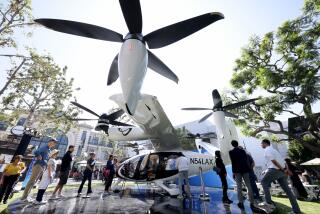Postal Service asks five firms to help it deliver in a green way
In the e-mail era, the U.S. Postal Service seems hardly plugged in -- but at least it wants its vehicles to be.
The postal service has awarded contracts to several California firms to develop a prototype postal van that would run on electricity.
The contracts are part of the service’s effort to determine whether it can convert some, or even all, of its 142,000 delivery vans to electricity. Such a project would be worth billions of dollars to the companies that win production contracts.
California businesses, such as AC Propulsion Inc. of San Dimas, hope to become big players in the postal service’s initiative to be more environmentally friendly.
AC Propulsion is part of a two-company team that is retrofitting a post office delivery van into a plug-in electric vehicle.
“We will get the vehicles back in June or July and put them into service in the Washington, D.C., area, where we can monitor their cost and reliability,” said Joseph McGrath, a program manager at the postal service’s vehicle engineering division in Merrifield, Va.
AC Propulsion will develop the drive system and retrofit the van at its San Dimas plant in conjunction with AutoPort Inc., an automotive conversion company in New Castle, Del.
Previously, AC Propulsion helped Tesla Motors of San Carlos, Calif., create its $109,000 electric Roadster and produced the drivetrain and battery for a test fleet of BMW’s electric Mini brand cars.
The postal service last month awarded $50,000 contracts each to the AC Propulsion-AutoPort team and four other companies, asking each to create a prototype electric postal van out of the agency’s so-called Long Life Vehicle vans. The LLVs were specially designed delivery vans built for the postal service in the 1990s.
Two other California firms -- electric vehicle maker Zap of Santa Rosa and Quantum Technologies Inc. of Irvine, which has worked on Fisker Automotive’s Karma sports car project -- also won contracts.
The other companies getting grants were EDAG Inc. of Auburn Hills, Mich., the American arm of a German company, and Bright Automotive Inc. of Anderson, Ind.
“I couldn’t conceive of a better application for an electric vehicle than as a postal service delivery van,” said David Mazaika, chief operating officer of Quantum Technologies.
Postal trucks typically travel a short range rarely more than 25 miles daily, easily navigable on one battery charge battery. They usually move at low speeds, reducing the drain on the batteries, Mazaika said. And they are maintained by “trained fleet mechanics,” he said.
The demonstration projects will probably show the postal service that it can save money and produce a better-driving and more environmentally friendly vehicle than it uses now, said Tom Gage, AC Propulsion’s chief executive.
“I took the truck we are converting for a drive, and it was no thrill ride,” he said.
Postal trucks are subject to constant stops and starts and low-speed idling, the type of driving “that is about the worst use of a gasoline engine” because it gobbles up fuel and spews pollution, Gage said.
But that type of use, he said, is ideal for an electric van with regenerative braking, which feeds the energy created by slowing and stopping the vehicle back to its battery system.
The aging LLVs were built by a predecessor of Northrop Grumman Corp. in the 1990s. They have a modified General Motors S-10 Blazer powertrain and chassis and can carry 1,000 pounds of mail.
The post office is looking at replacing them between 2011 and 2018.
The typical LLV gets about 10 miles to the gallon and is on its second engine and its third or fourth transmission, according to the postal service. It is driven five to six hours a day, 302 days a year and about 16 miles a day. The bodies are built from a rustproof aluminum designed to last at least 24 years.
“The vehicle we got has a pretty solid body and interior. It would make sense to retrofit it and keep using it,” Gage said.
The postal service has toyed with electric cars and vans for more than a century but never adopted them for widespread use.
In 1899, for example, a carrier used a Winton electric auto to deliver mail in Cleveland. It took less than half the time of his regular transport, a horse-drawn wagon.
A decade later the post office branches in Boston and New York used electric mail vans for several years but eventually switched to gasoline-powered vehicles.
The post office tried again in the late 1960s, ordering 300 electric vehicles from Highway Products Co. but dumped them because of poor acceleration and low speeds.
Since then, the agency has tried out small numbers of electric Jeeps, Ford Ecostar vans and a GM/Hughes Aircraft vehicle, but never put the vehicles into national service.
Whether one of this newest generation of electric vehicles will make it into the postal service’s fleet is far from certain, McGrath said.
“We don’t know what drive train we want,” for the next generation of postal truck, McGrath said, adding only that electric vehicles have “potential.”
Mazaika, of Quantum Technologies, doesn’t think it’s any surprise that so many California companies are involved in the postal service project.
“The state is a hotbed of electric vehicle design and engineering,” he said. “We have the expertise here in California, and now is a great opportunity to leverage that knowledge and bring more of this work here.”
twitter.com/latimesjerry







